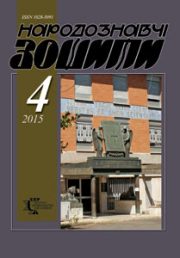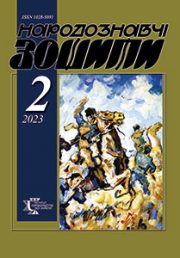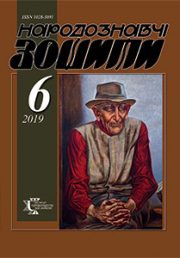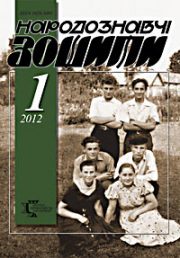The Ethnology Notebooks. 2025. № 5 (185), 1168—1179
UDK069.5:316.647.6:929О.Заливаха
THE FIRST SOLO EXHIBITION OF OPANAS ZALYVAKHA IN THE LIGHT OF NEW SOURCES. To the 100th anniversary of his birth
BABII Nadiia
- ORCID ID: https://orcid.org/0000-0002-9572-791X
- Doctor of Art History, Professor,
- Vasyl Stefanyc Precarpathian National University,
- 57, Shevchenka Str., 76000, Ivano-Frankivsk, Ukraine,
- Contacts: e-mail: nadiia.babii@pnu.edu.ua
Abstract. The aim of the study is to systematize the actual source base in order to identify and analyze potential documents that reveal the date and content of the first solo exhibition of the artist Opanas Zalyvakha in Ivano-Frankivsk.
The relevance of the research is connected to the celebration of the artist’s 100th anniversary.
In the course of the study, a number of sources were introduced into academic circulation for the first time, clarifying the date of the event and defining its content. It has been established that the exhibition took place on 15 April 1962 and was dedicated to Artist’s Day. A total of 50 works were exhibited: 47 paintings and 3 graphic works. It has been demonstrated that the premature closure of the exhibition was caused by the experimental manner of execution, the subjects of the works, and their resonance in society, which did not correspond to the demands of socialist realist art. The comparison of all sources enabled the attribution of 21 works.
This outcome provides an opportunity to explore the style and manner of the artist’s earliest creative period. The specific research results are presented in tabular form in the appendices to this publication. It has also been established that the published sources — albums and catalogues of Opanas Zalyvakha’s works — contain a number of discrepancies, which complicate an objective assessment of his oeuvre.
Methodology. The research relies on methods of comparison, analogy and scientific modeling, which have made possible detection and identification a range of artifacts from Zalyvakha’s first solo exhibition in later catalogues, in private collections and at auctions. Iconological and graphographic methods, along with the interview method, were applied to clarify the attribution of certain works to exhibition catalogues.
Keywords: visual art, Opanas Zalyvakha, first solo exhibition, the Sixtiers movement, repressed art.
Received 11.09.2025
REFERENCES
- (1996). Opanas Zalyvakha. Painting, graphics, carving. Catalog. Ivano-Frankivsk: Lileia-NV [in Ukrainian].
- (2016). Opanas Zalyvakha. Catalog. Ivano-Frankivsk: Lileia-NV [in Ukrainian].
- (2003). Opanas Zalyvakha. Album. Kyiv: Smoloskyp [in Ukrainian].
- (2013). Opanas Zalyvakha. Victoria [in Ukrainian].
- Paska, B. (2020). Dissident activities of Opanas Zalyvakha (1960s—1970s). Galicia (Pp. 149—158) [in Ukra inian].
- Andrukhovych, Yu., & Yakovyna, M. (2002). The right to free flight. From: M. Yakovyna. Chronicle of RUKh. Lviv: Library of the Journal Yi[in Ukrainian].
- (2017). Bell ringer. A сollection of articles and memoirs about Opanas Zalyvakha. Kharkiv: Human rights [in Ukra inian].
- Ovsienko, V. (1999, September 20). Interview with Opanas Zalyvakha. Interview from Ukraine. Retrieved from: https://rozmova.wordpress.com/2019/01/25/opanas-zalyvakha-2/ [in Ukrainian].
- (2024, 20.02). Private archive of N. Babii. Nadiіa Babii with Stepan Ostasha [Interview] [in Ukrainian].
- (2025, 30.01). Private archive of N. Babii. Nadiіa Babii with August Basiuk [Interview] [in Ukrainian].
- Synytsia, & Baranov. (1965). Record of the search at artist Opanas Zalyvakha’s dated August 28, 1965. Ukrainian Liberation Movement.[manuscript]. Retrieved from: https://avr.org.ua/viewDoc/29535 [in Ukrainian].
- Zalyvakha, O. Cassation appeal of the convicted Opanas Zalyvakha to the Supreme Court of the Ukrainian SSR dated March 25, 1966. Ukrainian Liberation Movement. [manuscript]. Retrieved from: https://avr.org.ua/viewDoc/29595?locale=en [in Ukrainian].
- Zalyvakha, O. Letter to the Prosecutor of the Ukrainian SSR, dated 21.10.1988. Central State Archive-Museum of Literature and Art of Ukraine [manuscript]. [in Ukrainian].
- Koterlin, R. (2000). Interview with Panas Zalyvakha. November, 1999. Kinets Kintsem, 2, 23—28[in Ukrainian].
- Picture of the day: Opanas Zalyvakha. «Teahouse», 1962. 26 листопада 2020 р. Retrieved from: https://www.facebook.com/MuseumOfUkrainianPainting/posts/pfbid02ULbs2LQHMoWxQoJcDGkN6ZXiN9be9451o9qnkV2rN1j3Lk6vWv8czursbEwSteUkl [in Ukrainian].
- Zalyvakha, O. Teahouse, 1965. Retrieved from: https://gs-art.com/auctions/underground/catalog/7383/ [in Ukrai nian].
- Zalyvakha, O. Hook waterfall, 1958. Retrieved from: https://gs-art.com/auctions/classic-contemporary-art-50/catalog/12294/ [in Ukrainian].
- Zalyvakha, O. In the Carpathians, 1963. Retrieved from: https://www.olx.ua/d/uk/obyavlenie/prodam-kartinu-opanas-zalivaha-v-karpatah-1963-rk-holst-maslo-IDVtFwZ.html [in Ukrainian].
- (2024, 23.02). Private archive of N. Babii. Nadiіa Babii with Iryna Chmelyk [Interview] [in Ukrainian].
- (2003). Private archive of I. Chmelyk. Catalog of the exhibition of works by the artist O. Zalyvakha 1962 from the private library of the Figol family [manuscript] [in Ukrainian].
- Private archive of Liubov Lytvynchuk. Opanas Zalyvakha. Catalog of a personal exhibition: painting, graphics, ceramics, carving [in Ukrainian].
- (1961). Exhibition of works by artists of the Tyumen region. Catalog: painting, graphics, sculpture and applied arts. Tyumen [in Russian].
- (2025). Self-portrait. Exhibitions for the artist’s day. Catalog. Ivano-Frankivsk: Territory of Printing [in Ukrainian]
- Karazub, I. An exhibition dedicated to the centenary of the 1960s artist Opanas Zalyvakha opened in Frankivsk 13.03.2025. Suspilne. Retrieved from: https://suspilne.media/ivano-frankivsk/970055-u-frankivsku-vidkrili-vistavku-do-storicca-hudoznika-sistdesatnika-opanasa-zalivahi/ [in Ukrainian].







